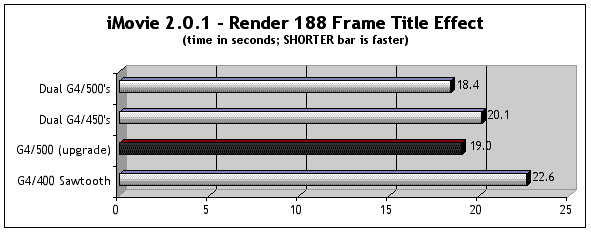
Should I upgrade the CPU on
my G4/400 Sawtooth
or sell it and buy a Dual G4?

Should I upgrade the CPU on
my G4/400 Sawtooth
or sell it and buy a Dual G4?
MacSelect is selling a G4/500 daughterboard upgrade for the Sawtooth for $599 exchange. If you have a 350MHz or 400MHz G4 Sawtooth, this is a tempting upgrade. And it's really easy to install and no software drivers are required.However, it's possible that you could get more speed gain per dollar if you buy a new Dual G4 Sawtooth (and subtract the amount you get for selling your old machine). Let's see what we find out...
First posted 9/15/2000
© 2000 Rob Art Morgan, publisher of BARE FEATS
rob-art@barefeats.comFirst, The Performance Gains...
The four functions are Rotate, Gaussian Blur, Render LightingEffects (Flashlight), and Motion Blur.
Cinema 4D is my NEWEST "real world" TEST. It's a 3D modeling application. The Dual 500 renders almost twice as fast as the Single 500.
Those results favor dual G4's but what about...

As you can see, the "Dualies" have very little advantage here.
With SoundJam MP Plus, the Dual 500 has a 17% advantage over the Single 500. I'm not impressed.
Definitely not impressed.
Now, For The Cost Factor
Let's say you own a G4/400 Sawtooth. You can spend $600 for a G4/500 daughterboard or you can sell your G4/400 for $1000 (estimated used value) and buy a new Dual G4/450 or 500.In an attempt to make a fair comparison to the G4/400, I priced a "stripped down" BTO Dual G4/450 at $2200 on Apple's Online Store. That's with 64MB of RAM, 20GB Hard Drive, 56K Modem, and RAGE 128 Pro. A similarly equipped Dual G4/500 goes for $2500. Remember, if you added memory, hard drives, etc., to your old Sawtooth, you can use them on the new one.
Now, if you subtract the selling price of your G4/400, your NET cost is $1200 for the Dual G4/450 and $1500 for the Dual G4/500.
So here's the bottom line: You can speed $600 for one G4/500 CPU or $1200+ for dual G4 CPU's.
What To Do...
This issue hits me personally. I do most of my work on a G4/400 Sawtooth. I'm a heavy user of Photoshop so trading in for the dual G4 machine is very tempting, especially when I know I can add the Radeon graphics card for only $100 more.But the Dual G4 will cost me twice as much as the G4/500 upgrade for the 26% average gain in Photoshop speed. And selling old machines is a pain.
If I go with the G4/500 upgrade, I could use the money I save to get both the 3Dfx Voodoo5 5500 AGP or PCI card and Radeon graphic accelerators to drive my dual monitors... and have $20 left over for pizza. Yeah, that's the ticket.
But on the other hand, I've heard there will be an "across the board" gain in speed using dual G4's when OS X is released. (I'll be testing the Dual G4's with a beta version of OS X real soon now to see if I can back up that claim with hard data.)
I can't decide. Write and tell me what you think.
One More Thing...
PowerLogix and XLR8 have announced that they are working on a dual G4 upgrade. Here's a nightmarish thought: about the time I buy the G4/500 daughterboard, they start shipping the dual G4 daughterboard for about the same price. (Insert sound of me violently vomiting!)
Test Configurations & ProceduresTEST Apple Macintosh MACHINES: Dual 500MHz PowerPC G4, Dual 450MHz PowerPC G4, 500MHz PowerPC G4, and 400MHz PowerPC G4. All systems had 256MB of PC-100 "222" memory. On all machines, virtual memory was off, disk cache was set to minimum (128K), clock display was off, and AppleTalk was off.
Adobe Photoshop 5.5 was given 200MB of application size. The test file was a 27 MB Photoshop photo. The FOUR Photoshop effects were timed using Photoshop's built-in timer. The effects included:
1. ROTATE Clock Wise at 30 degrees.
2. GAUSSIAN BLUR at 30 pixels
3. RENDER LIGHTINGEFFECTS - flashlight, default settings
4. MOTION BLUR (30 pixels at 30 degrees)
A DEMO version is available from Adobe if you want to test your own machine.Maxon Cinema 4D 6.1 is a NEW REAL WORLD TEST I've just added. It's a 3D modeling application. I'll probably use it from now on in place of, or in addition to, Bryce 4.0 since it is "dual CPU aware" and Bryce is not. Cinema comes with various example documents. I chose the "Shadows.c4d" file. I invoked RENDER (Shift + R). It keeps track of the rendering time to the nearest whole second. (A DEMO version is available on their website.)
I used the newest 2.01 version of Apple's iMovie. I ran the "render titles" function as a test since it's so CPU intensive. I typed in a two line title ("My Great Movie by rob art mog") using default settings. Then drag/dropped it in the "story line." I used a stopwatch to time how long it took to render the 188 frames. (If you don't have iMovie 2.0, version 1.02 is available for FREE from Apple's web site. Only catch is that if you duplicate my test using version 1.02, it only renders 122 frames. However, when you do the math, they both render the same number of frames per second.)
Casady & Greene's SoundJam MP Plus 2.5.1 was used to convert a 2.5 minute music selection into MP3 using default settings. With a stop watch, I timed it to the nearest tenth of a second. A DEMO version is available from their website.
BIG MAHALO TO...
CompUSA Honolulu for letting me test their floor demonstrators (Dual 500, Dual 450).
MacSelect for letting me test the G4/500 daughterboard upgrade.
SmartDisk/VST for the use of one of their 6GB portable FireWire drives which holds all my latest test applications, test documents, and drivers as I move from test machine to test machine.
© 2000 Rob Art Morgan, editor of
BARE FEATS
Gotta Question? Comment? Want to advertise?
Email rob-art@barefeats.com